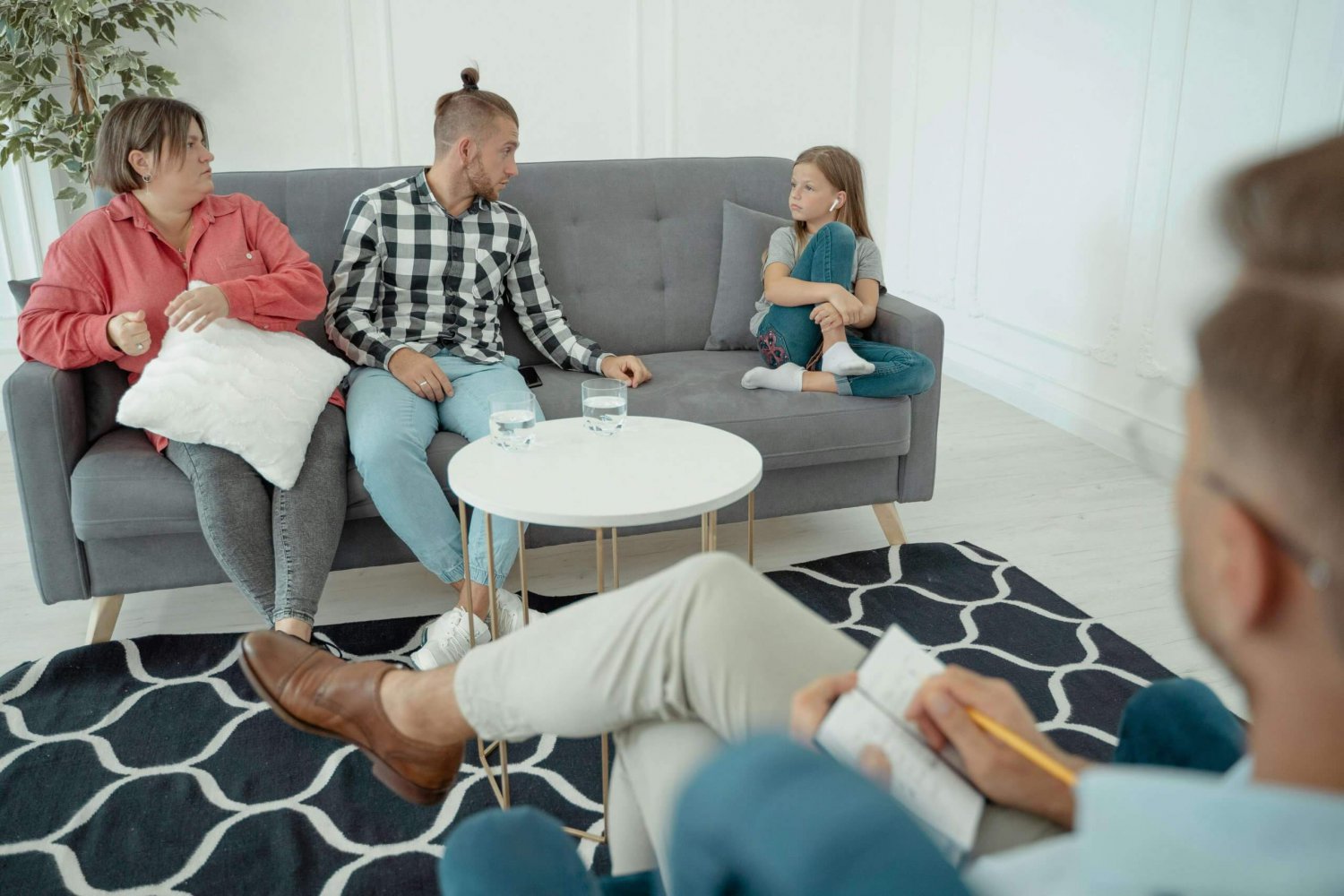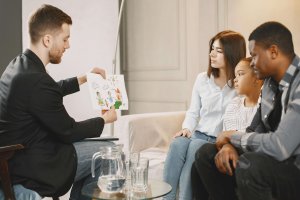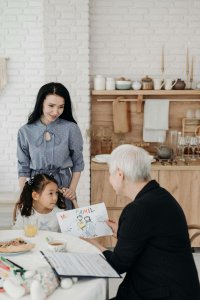It’s no secret that uncomfortable situations in a family are difficult, or even impossible, to unpack . Some families choose not to discuss the uncomfortable or difficult things they have experienced. On the other hand, some families choose to work with a professional, like a family therapist, to improve family dynamics and ease conflict. This is done through evidence-based approaches, such as talk therapy sessions with the family and the therapist.
Did you know that there are other evidence-based approaches to family counseling? And they don’t include just sitting and talking with your family! Art Therapy, for example, can be a powerful tool to explore family dynamics. Family art therapy sessions can help family members express emotion, recognize patterns, and process difficult experiences. This could look like creating an artistic family tree, which can point out some of the similarities and differences you may notice in your family.
What Can an Art Therapist in Branchburg NJ Do For Families?
Have you ever tried to create a family tree, trying to trace back from generation to generation? This is very similar to what family therapists do while creating a genogram. The difference is that a family therapist might notice patterns that you or your family don’t! Developed by renowned psychiatrist Murray Bowen, genograms help therapists keep track of important information within a family.
As a family therapy client, genograms can help you capture the different generations in your family. It can also highlight different types of relationships, and even other important characteristics your family members have.
Genograms can highlight patterns like:
- Remarriages
- Separations
- Divorce
- Health traits, such as…
- Diabetes
- Autoimmune conditions
- Heart disease
- Mental health diagnoses
- Generational strengths and traumas
A genogram is one of the many ways of drawing a family tree to visualize the complex dynamics that can come up within a family.
Family Therapy in NJ: The Power of Structural Family Mapping
Another helpful diagram that some therapists may use for family counseling is structural family mapping. This technique comes from Structural Family Therapy, which is an approach in family counseling that focuses on boundaries, power dynamics, and interconnectedness within a family.
Like with a genogram, the therapist can invite family members to use different shapes, colors, and connections to represent some of the characteristics and dynamics of the family in a structural family map. The difference is that structural family mapping is a little easier to understand than a genogram. Both tools can be used to help you better understand why two family members can’t seem to get along or even help with setting healthy boundaries.
What Art Therapy Can Look Like in Family Therapy
When meeting with an art therapist who works with families, you’ll begin to experience a unique approach that builds on traditional family counseling techniques. Through intentional diagramming and creative, art-based activities, your art therapist will help highlight what is happening in your family dynamic.
You won’t need to be “good” at art. These activities are designed to help you and your family focus on the process and make it easy for every family member–regardless of artistic ability, to help express their feelings and perspectives.
These activities can help engage your entire family, leading to deeper understanding of relationship patterns and intentional communication between every member. This specialized approach of family art therapy offers a powerful way to visualize and address the underlying dynamics that affect your family’s wellbeing.
Kids and teenagers are some of Family Art Therapy’s biggest fans. Kids can express how they feel, and parents have support in responding to their child’s needs. Art therapy can even help family members understand how trauma can be passed down from generation to generation. Art therapy in a family counseling session can also help family members deal with their emotions by using images, color, and metaphor, instead of just talking. This can be really helpful when just starting to talk and navigate through some tough subjects. For example, it may be easier for a child navigating through their parents’ divorce to draw out what they are feeling, compared to trying to find the words for their mixed emotions.
Still not sure what art therapy in family counseling looks like? Here are some examples:
- Kinetic Family Drawings, which typically involve a client drawing out themselves and their family all doing something together
- Genogram Collage, which combines family dynamics with representing each member by using found images
- Joint Family Drawings, a method popularized by art therapist, Helen Landgarten, who combined art and play therapy to create a way of artmaking that involves the whole family
What Can Be Done Outside of Therapy?
While there are many ways that art therapists can incorporate art into family counseling sessions, there are also many ways to get creative with your family members while at home! Look below for two fun art therapy activities to try with your family members, as well as other creative ways to connect with your family.
Art-Based Activities To Try With the Family
Not every art therapy activity needs to be done in a therapeutic space with an art therapist. Here are some great suggestions for artmaking that can be done within the comfort of your own home!
- A “Shared Family Values Collage” can be a great way for parents to communicate with children what their expectations are, while also allowing children to express what values are important to them. Ideally, you want to make sure your child is also old enough to understand what values are!
-
- Materials:
-
-
-
- Old magazines, with images and words to choose from
- Adhesive (gluesticks or modge podge)
- A large piece of paper
- Scissors
- Colored pencils, markers, or crayons (to decorate the collage)
-
-
-
- Instructions:
-
-
-
- Ask your children to think about values that are important to them, especially ones that make them feel safe and heard. Additionally, take some time to think about what values may be important to you and make you feel similarly.
- Be open to having a conversation altogether about what these values are, and the moments that they typically come up at home
- After having a family discussion about values, work collaboratively to create a collage that includes all of the values that each family member came up with. Feel free to include images that may represent what these values can look like, or even words that reference what the values are
-
-
-
- Reflection:
-
-
-
- Consider asking your children questions such as:
- Are these family values that we currently practice, or not quite? How can we try to practice these values more?
- Why do you feel these values are really important to our family?
- Did you learn anything new about yourself or about our family during this activity?
- Consider asking your children questions such as:
-
-
- “Family Mandala Creation”
-
- Materials:
-
-
-
- Large paper roll sheet, circular-cut paper, or cardboard
- Colored pencils, markers, oil pastels/crayons
- Ruler
-
-
-
- Instructions:
-
-
-
- Draw a large circle into the center of paper roll, or use a circular surface, to place equally divided sections for each family member.
- Have each family member decorate their section with colors, patterns or symbols that best represent who they are
- In the center of this circular surface, create a shared area that every family member can draw something in
-
-
-
- Reflections:
-
-
- Ask each family member: why is it that they chose to represent themselves in this way?
- Ask your family members: how the center of this mandala speaks to who we are as a whole family?
- Ask the family how they felt about creating something together?
-
Other Creative Ways To Connect With Family
After reviewing some great art therapy activities that can be done with the family, you may be wondering, what are some creative ways to connect with family that don’t always rely on artmaking?
Here are some great examples of how to get your whole family involved in activities that boost connection and healthy communication:
- Create new family traditions that aren’t just reserved for holidays, such as family walks in the park over the weekend, or Sunday movie nights with family reflections to follow
- Try something new together, like taking a family baking class, or learning how to paint altogether
- Consider exploring collective activities to do at home, whether that may be having scheduled unplugged hours to have family discussions, or even a family book club where family members can vote on what to read next
- Create a family bucket list so that everyone can have a turn at suggesting things such as the next planned family trip
- Make time to be silly when the time permits, such as family game nights, impromptu dance parties or karaoke nights, which can be great when a relaxing break is needed for the family
Ready to Transform Your Family Dynamics Through Art?
You don’t need to be an artist to benefit from art therapy. Whether you’re struggling with communication barriers, processing difficult emotions, or simply want to strengthen your family bonds, art therapy offers a unique and powerful approach to family healing.
Take the First Step Today:
- Schedule a consultation with our experienced therapists in Branchburg and Scotch Plains NJ to discuss your family’s specific needs.
- Meet with a therapist and start to incorporate art therapy into your sessions to begin strengthening your family bonds.
- Begin Healing and continue to use art therapy skills in your daily life
Don’t wait for family tensions to escalate. Art therapy provides a safe, creative space where every family member can express themselves and be heard.
A Family Therapist in NJ Can Help!
Beyond family art therapy, our practice provides a comprehensive range of mental health services to support you and your loved ones. We offer couples counseling, family therapy and parent coaching to help support you and your family through any challenges you may be facing.
We also offer individual therapy for children, teens, adults, and specialized trauma-informed care for those who have endured a traumatic event. Whatever challenges you’re facing, our diverse therapeutic approaches—including CBT, EMDR, and play therapy—ensure we can tailor treatment to your specific needs while incorporating creative elements that promote healing and growth.




